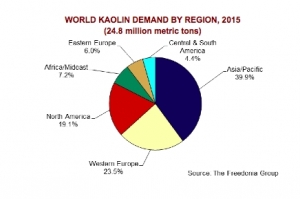05.29.15
World demand for silicones is forecast to rise 5.7 percent per year to $19.3 billion in 2019. The pace of growth in value terms will be in line with that seen over the 2009-2014 period, largely due to an improved outlook for silicone prices. Demand for silicones in developing regions is expected to post strong gains through 2019, benefiting from economic advancement and increased penetration of silicones in less mature markets. These and other trends are presented in World Silicones, a new study from The Freedonia Group, Inc., a Cleveland-based industry research firm.
The Asia/Pacific region will continue to be the strongest source of additional silicone demand, accounting for 57 percent of the total increase in global silicone consumption between 2014 and 2019. The bulk of these gains will be attributable to China, which will represent nearly three-fifths of the Asia/Pacific total in 2019. According to analyst Elliott Woo, “although China’s silicone market will not maintain the extremely rapid pace of gains seen in recent years, growth will still continue to be well in excess of the global average.” Other developing countries in the Asia/Pacific region, such as India, Indonesia, and Thailand, are also expected to post strong gains in silicone demand. Electrical and electronic products will remain the largest outlet for silicones in the Asia/Pacific region, reflecting the region’s dominance in global electronics manufacturing.
The outlook for silicone demand in North America and Western Europe is somewhat weaker, reflecting the maturity of both manufacturing industries in general and the use of silicones. In the US market, the largest in the world, demand for silicones will be bolstered by a major improvement in construction activity. Demand for silicones in Western Europe will advance slowly, although the region’s affluence will continue to support significant demand for silicones in the health and personal care market. Above average growth is expected in the Africa/Mideast region, aided by urbanization and the emergence of the middle class in some of the more developed nations. Gains in silicone demand in Central and South America will be near the world average, benefiting from a rebound in motor vehicle production from low 2014 levels. Gains in Eastern Europe are expected to be slightly below the world average, but will still represent a healthy increase through 2019 as export-oriented manufacturing activity continues to grow.
The Asia/Pacific region will continue to be the strongest source of additional silicone demand, accounting for 57 percent of the total increase in global silicone consumption between 2014 and 2019. The bulk of these gains will be attributable to China, which will represent nearly three-fifths of the Asia/Pacific total in 2019. According to analyst Elliott Woo, “although China’s silicone market will not maintain the extremely rapid pace of gains seen in recent years, growth will still continue to be well in excess of the global average.” Other developing countries in the Asia/Pacific region, such as India, Indonesia, and Thailand, are also expected to post strong gains in silicone demand. Electrical and electronic products will remain the largest outlet for silicones in the Asia/Pacific region, reflecting the region’s dominance in global electronics manufacturing.
The outlook for silicone demand in North America and Western Europe is somewhat weaker, reflecting the maturity of both manufacturing industries in general and the use of silicones. In the US market, the largest in the world, demand for silicones will be bolstered by a major improvement in construction activity. Demand for silicones in Western Europe will advance slowly, although the region’s affluence will continue to support significant demand for silicones in the health and personal care market. Above average growth is expected in the Africa/Mideast region, aided by urbanization and the emergence of the middle class in some of the more developed nations. Gains in silicone demand in Central and South America will be near the world average, benefiting from a rebound in motor vehicle production from low 2014 levels. Gains in Eastern Europe are expected to be slightly below the world average, but will still represent a healthy increase through 2019 as export-oriented manufacturing activity continues to grow.





